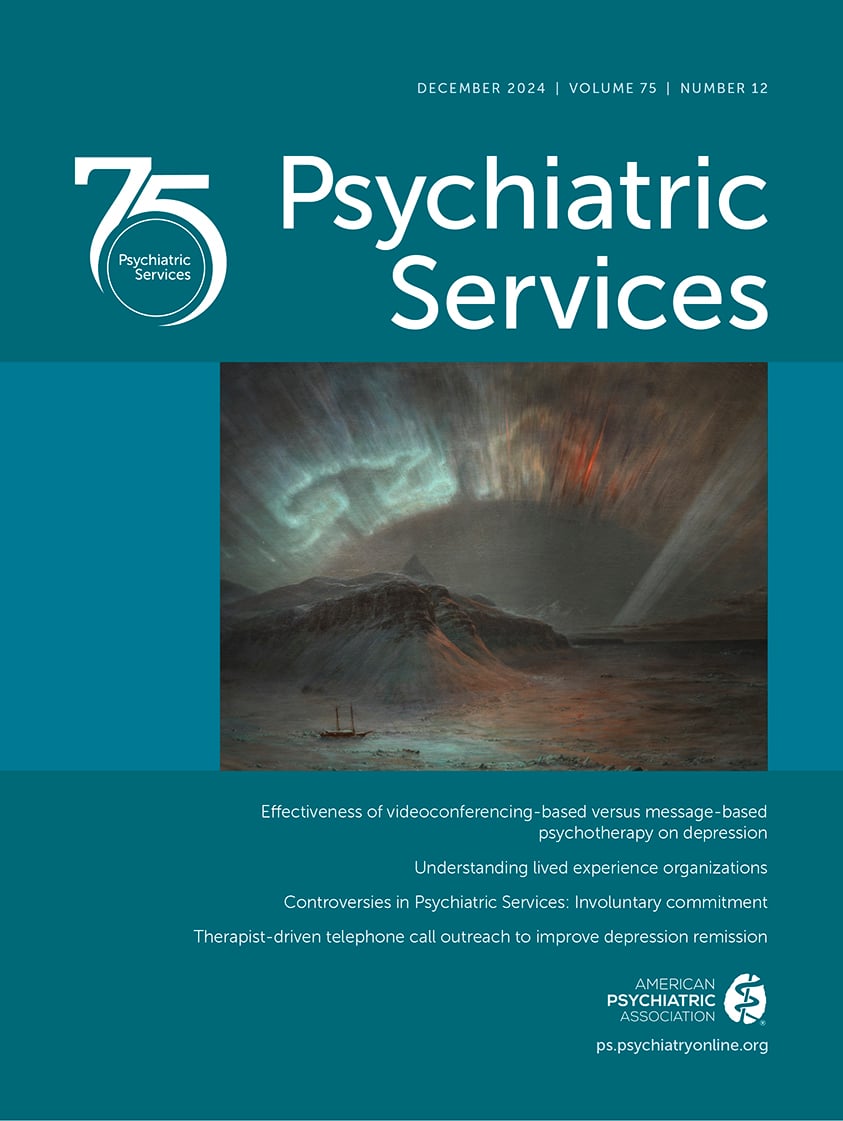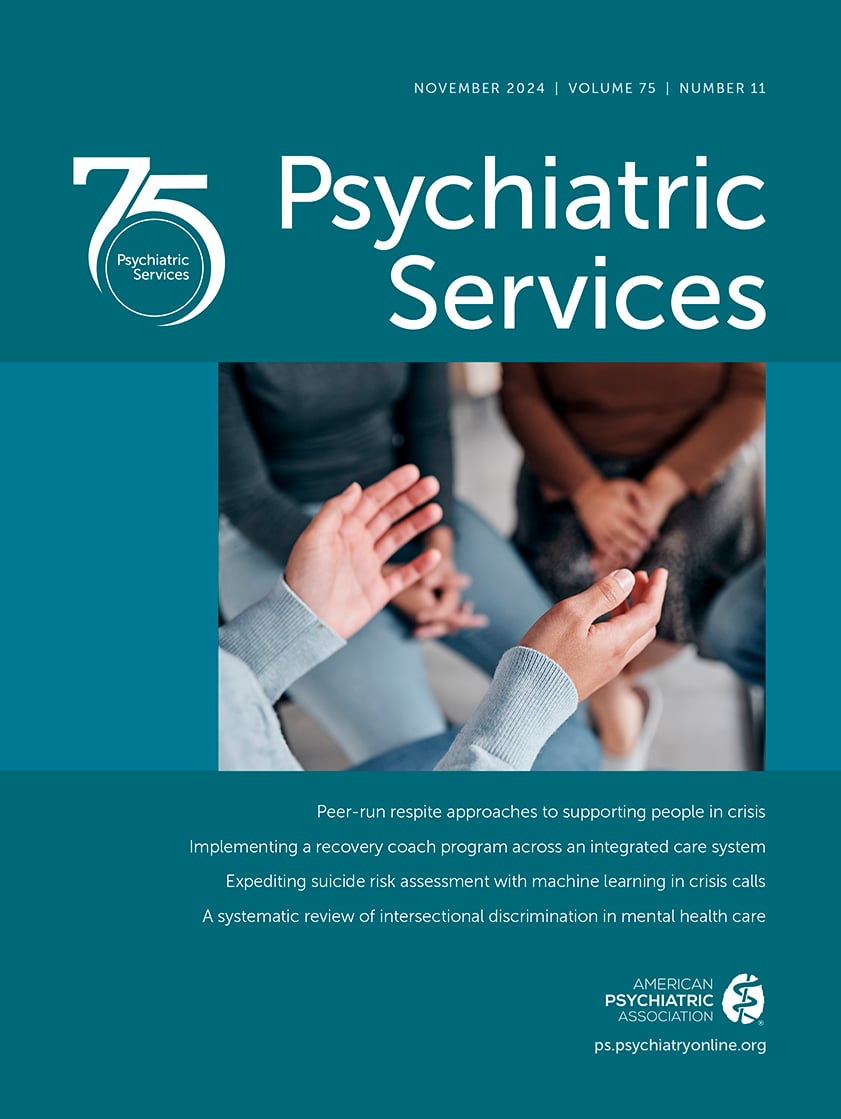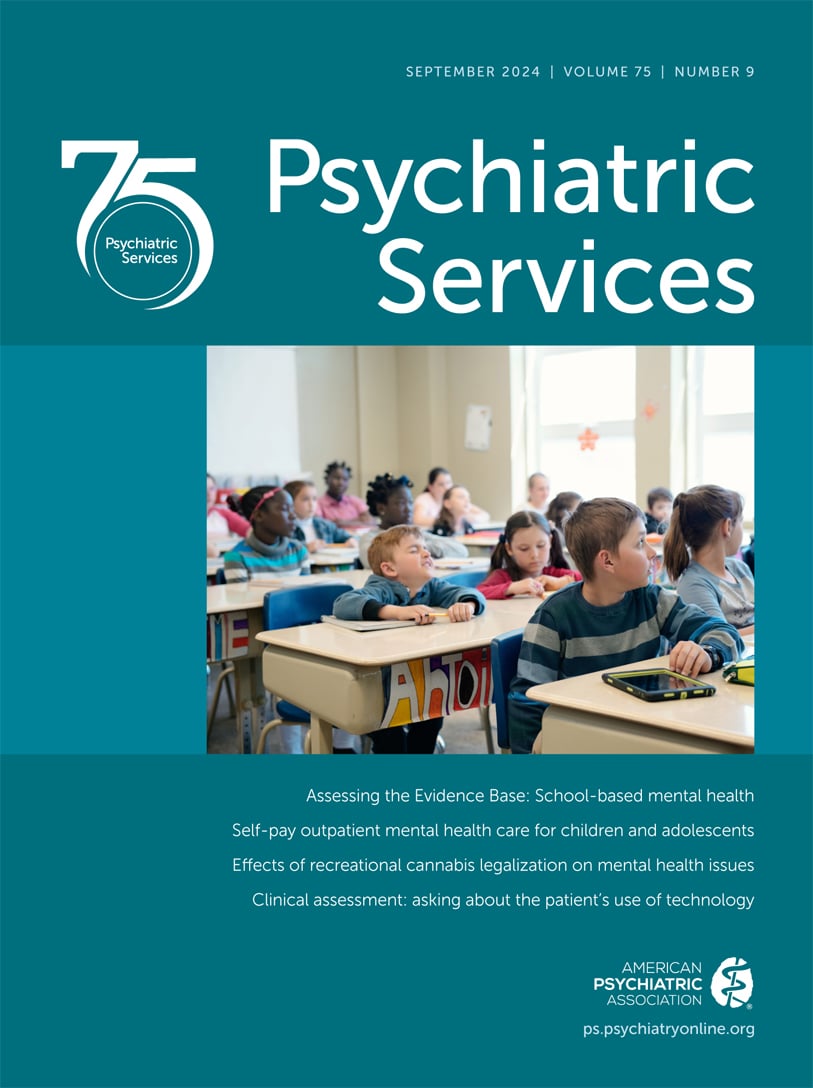Psychiatric Services
- Volume 68
- Number 8
- August 2017
Taking Issue
Articles
Publication date: 01 May 2017
Pages764–770Objective: In youth mental health services, consumer participation is essential, but few implementation strategies exist to engage young consumers. This project evaluated an intervention implemented in an Australian youth mental health service that ...
https://doi.org/10.1176/appi.ps.201600388Publication date: 03 April 2017
Pages771–775Objective: Discordance between psychiatric care providers’ and clients’ goals for medication treatment is prevalent and is a barrier to person-centered care. Power statements—short self-advocacy statements prepared by clients in response to a two-part ...
https://doi.org/10.1176/appi.ps.201600418Publication date: 17 April 2017
Pages776–782Objective: Use of administrative data from child welfare (CW) and mental health systems in Los Angeles County provided a unique opportunity to more closely examine mental health needs of children dually served by these systems. This study examined the ...
https://doi.org/10.1176/appi.ps.201600266Publication date: 17 April 2017
Pages783–788Objective: People with mental illness struggle with symptoms and with public stigma. Some accept common prejudices and lose self-esteem, resulting in shame and self-stigma, which may affect their interactions with mental health professionals. This study ...
https://doi.org/10.1176/appi.ps.201600282Publication date: 03 April 2017
Pages789–795Objective: The aim of this study was to examine the determinants of use of mental health services for children across Europe, with a specific focus on differences in the availability of mental health resources. Methods: Data were drawn from the School ...
https://doi.org/10.1176/appi.ps.201600409Publication date: 17 April 2017
Pages796–802Objective: Depression is a major public health concern and often goes untreated. In response to a growing body of research documenting stigma as a barrier to depression care, this study focused on examining public stigma toward potentially vulnerable ...
https://doi.org/10.1176/appi.ps.201600154Publication date: 17 April 2017
Pages803–809Objective: Approximately three to six months after returning from deployment, military service members complete the Post-Deployment Health Reassessment (PDHRA), which includes screens for alcohol misuse, depression, and posttraumatic stress disorder (PTSD)...
https://doi.org/10.1176/appi.ps.201600259Publication date: 17 April 2017
Pages810–818Objective: Individuals with substance use disorders are at high risk of hospital readmission. This study examined whether follow-up services received within 14 days of discharge from an inpatient hospital stay or residential detoxification reduced 90-day ...
https://doi.org/10.1176/appi.ps.201600339Publication date: 17 April 2017
Pages819–831Objective: The project goal was to compare the effectiveness of strategies to prevent and de-escalate aggressive behaviors among psychiatric patients in acute care settings, including interventions for reducing use of seclusion and restraint. Methods: ...
https://doi.org/10.1176/appi.ps.201600314Publication date: 01 May 2017
Pages832–838Objective: The community model of mental health care (CMMHC) is recommended as the best way to organize mental health care, but evidence of its successful implementation and effectiveness is scarce, particularly in resource-poor settings. This study aimed ...
https://doi.org/10.1176/appi.ps.201600371Datapoints
Integrated Care
Publication date: 17 July 2017
Pages756–758Behavioral health integration with primary care has long been shown to be an essential part of improving health care and, more recently, of achieving the “triple aim” as part of national reform. Many states are promoting integration activities as part of ...
https://doi.org/10.1176/appi.ps.201700085Promoting High-Value Mental Health Care
Publication date: 03 July 2017
Pages759–761Depression is the most frequent psychiatric disorder in primary health care, and the evidence shows that there is suboptimal management by primary care practitioners, perhaps owing to difficulties in decision making. Because clinical guidelines can ...
https://doi.org/10.1176/appi.ps.201700163Personal Accounts
Brief Reports
Publication date: 17 April 2017
Pages839–842Objective: This study aimed to determine cervical cancer screening rates among women with severe mental illness. Methods: California Medicaid administrative records (2010–2011) for 31,308 women with severe mental illness were examined. Participants received ...
https://doi.org/10.1176/appi.ps.201600293Publication date: 17 April 2017
Pages843–846Objective: This study assessed differences in diabetes prevalence based on race-ethnicity among people with severe mental illnesses. Methods: This retrospective cohort study examined diabetes prevalence in 2009 among California Medicaid enrollees with severe ...
https://doi.org/10.1176/appi.ps.201600356Publication date: 03 April 2017
Pages847–850Objective: This study examined whether outpatients with a psychotic disorder who are at risk of hospitalization can be identified by using data from electronic medical records (EMRs). Methods: Data from EMRs of outpatients enrolled in two clinics for ...
https://doi.org/10.1176/appi.ps.201600334Publication date: 17 April 2017
Pages851–855Objective: A Web-based survey examined treatment seeking among community college students to inform the design of engagement interventions. Methods: Veteran and civilian community college students (N=765) were screened for mental disorders and reported ...
https://doi.org/10.1176/appi.ps.201600240Publication date: 03 April 2017
Pages856–858Objective: This study reports the extent to which states have adopted the national culturally and linguistically appropriate services (CLAS) standards. Methods: Officials from public mental health agencies in the 50 states, Washington, D.C., and Puerto Rico ...
https://doi.org/10.1176/appi.ps.201600407Letters
Past Issues
View Issues Archive
Vol. 75 | No. 12

Vol. 75 | No. 11

Vol. 75 | No. 10
